|
Page < 1 2 3 4 5 6 7 8 9 10 11 12 13 14 15 16 17 18 19 20 21 22 23 24 25 >
Show
in alphabetical order
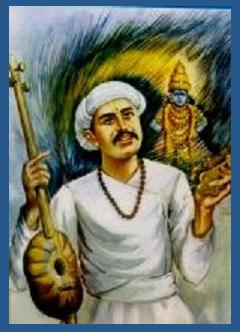 361.
Sant Tukaram (1608 – 1649) is one of the saints who produced an
extraordinary influence on the Marathi world through his poems. He speaks of God
as Vitthal, Vithoba, or Pandurang, local names for God Vishnu. 361.
Sant Tukaram (1608 – 1649) is one of the saints who produced an
extraordinary influence on the Marathi world through his poems. He speaks of God
as Vitthal, Vithoba, or Pandurang, local names for God Vishnu.
Few have felt the inherent tragedy of the human condition
with such sensitivity as Tukaram. The times and his personal life and emotions
show through his poetry with extraordinary clarity. The sorrows of his life were
the occasion for spiritual elevation.
He was a contemporary
of King Shivaji
and a devotee of Vithal.
His teachings are contained in Abhangas. His parents were poor agriculturists of
Maratha community but of pious and charitable nature. Their family deity was Vithoba
of Pandarpur. As a petty farmer and trader, Tukaram innocent of
worldly ways, and was cheated and humiliated in dealings. His life is a favorite
topic for Keertankars (reciters and story tellers in praise of God) as it is
full of dramatic incidents of misadventures of an unworldly man. He was
initiated into the spiritual path by one Babaji
Chaitanya. This may have been the famous deathless yogi Babaji but
there is no indication either way.
Caste and class do not come in the way of God-realization, he declared. He
emphasised the life divine and explained his desire for the Amrita. He stated
that the attainment of the Amrita is through the Nama and man’s liberation is
through the Amrita.
He considered that his destitution was a needed condition for
his higher spiritual achievement, his greater love of God.
At this time the Marathi saints had developed to a high
degree an informal ecstatic ritual known as the kirtan. Tukaram
addressed his songs to the Lord-of-Pandhari…
" While Tuka in his
love was thus pleading for God’s mercy, though still in his
body, he became one unconscious of body, and by force of his
devotion accompanied with love, the image of Pandurang appeared
in his heart. In his love for God he began to dance in the
kirtan, and moment after he would bow prostrate on the ground.
(In his ecstasy) Tuka forgot his relation as bhakta (devotee),
and Vithoba forgot his relation as God.”

Tukaram addressed his songs to the Lord-of-Pandhari (God Vishnu).
***
He took to wandering around many towns and
performing devotional songs, the kirtans, at Dehu, Loehgaon and Poona. These
were strongholds of the Brahmans who were particularly rigid about the rules and
regulations of caste and scripture at the time as they were under serious attack
from the Mughal Aurangzeb who was in a frenzy of piety over his faith and
demonstrating it by attacking the religious places and forbidding the practices
of the faiths of others. It is instinctive to huddle together and hold ever more
tightly to the rules that define a community at such times and here was this
lower caste upstart coming along and singing that the rules and caste did not
matter only love for god did.
He grimly sang:
Sainthood is not available in the bazaar,
It is gained by paying one’s life
All else is bragging.
He was naturally subject to every form of persecution.
Tukaram did not care; he was too busy singing about his beloved Vithobha to
notice.
(source: Religions
of India: Hinduism, Yoga, Buddhism - By Thomas Berry p. 53 - 54 and
indiayogi.com).
362. Dr.
Matheson
( ? ) wrote: "It is not too much to say that the mind of
the West with all its undoubted impulses towards the progress of
humanity has never exhibited such an intense amount of
intellectual force as is to be found in the religious
speculations of India.....These
have been the cradle of all Western speculations, and wherever
the European mind has risen into heights of philosophy, it has
done so because the Brahmin was the pioneer.
There
is no intellectual problem in the West which had not its earlier
discussion in the East, and there is no modern solution of that
problem which will not be found anticipated in the East."
"We may
think this language too strong but we shall never again
depreciate the intellectual value, the philosophic subtleties,
the religious purpose of the sacred books of the East."
(source: Is
India Civilized - Essays on Indian Culture - By Sir John
Woodroffe p.138 -139).
 363.
Philip
Rawson
( ? ) academic, and artist and
author of The
Art of Southeast Asia has written: 363.
Philip
Rawson
( ? ) academic, and artist and
author of The
Art of Southeast Asia has written:
“The
culture of India has been one of the world’s most powerful
civilizing forces. Countries of the Far East, including China,
Korea, Japan, Tibet and Mongolia owe much of what is best in
their own culture to the inspiration of ideas imported from
India. The West, too has its own debts. But the members of that
circle of civilizations beyond Burma scattered around the Gulf
of Siam and the Java Sea, virtually owe their very existence to
the creative influences of Indian ideas. No conquest or
invasion, no forced conversion imposed upon them. They were
adopted because the people saw they were good and that they
could use them. “
“The
sculptures of Indian icons produced in Cambodia during the 6th
to the 8th centuries A.D. are masterpieces,
monumental, subtle, highly sophisticated, mature in style and
unrivalled for sheer beauty….”
“One
of the most interesting pieces of all is a fragmentary bronze
bust, from the western Mebon, of the God Vishnu
lying asleep on the ocean of non-being. Head and shoulders and
the two right arms survive. It shows the extraordinary, delicate
integrity and subtle total convexity of surface, which these
sculptors could achieve by modeling. Eyebrows, moustache and
eyes seem to have been inlaid, perhaps with gold, silver or
precious tone, though the inlay is gone and only the sockets
remain. This was one of the world’s
great sculptures.
Another magnificent bronze of Shiva,
from Por Loboeuk, suggests the wealth of metal art that once
must have existed in Cambodia (Kamboja) at the height of its
power."

This was one of the world’s
great sculptures. Recumbent, bronze image of Lord Vishnu lying asleep on the ocean of
non-being - Western Mebon, Cambodia.
One
of the most interesting pieces of all is a fragmentary bronze bust of this colossal image, the most
extraordinary bronze statue of Southeast Asia. Between two
cosmic periods, Lord Vishnu, lying on the snake Ananta (“He who has
no end”), is resting on the surface of the primordial waters.
(source: Great Civilizations: The Cultural History of Angkor
- By Jean-François Gonthier p. 15).
For
more refer to chapter on Greater
India: Suvarnabhumi and
Sacred
Angkor
***
"The genius of
the artists of that age was for relief. Indeed one might say
that Angkor Wat is a repertory of some of the most magnificent
relief art that the world has ever seen. The open colonnaded
gallery on the first storey contains over a mile of such
works, six feet high. The main sources for the relief
subject matter are the Mahabharata
and Ramayana, as well as
legends of Vishnu and his incarnation Krishna.
The wars of classical legend, in which incarnations of the
various persons of the Hindu deity triumph at length over
demonic adversaries. The artists’ skill is everywhere
apparent."
(source: The
Art of Southeast Asia - By Philip
Rawson p. 1 - 77. For more refer to chapter on Suvarnabhumi).
364.
Arthur
Osborne (1909 - 1970)
has lived with the Indian
sage, Sri Ramana Maharshi. He was a man of brilliant intellect
and introspective spirit. After graduating from Oxford, his
inner longing to experience the Supreme Reality ultimately
brought him to the hermitage of the great Indian sage, Sri
Ramana Maharshi. In Ramana's presence, Osborne's
literary abilities flourished, and he became a vehicle for the
genuine spiritual understanding that awakened within him. He
wrote some poems - including one on Arunachala.
His son was Adam
Osborne who invented the portable computer.
"The recognition of Pure Being as
one's Self and the Self of the universe and of all beings is the
supreme and ultimate truth, transcending all other levels of
doctrine without denying their truth on their own plane. This is
the doctrine of Advaita, non-Duality, taught by the ancient
Rishis and pre-eminently by Shankaracharya. It is the simplest
as well as the most profound, being the ultimate truth beyond
all the complexities of cosmology."
(source: The
Collected Works of Ramana
Maharshi - By Arthur Osborne). Refer to Osborne's
India - hvk.org).
 365.
Jeffrey
Armstrong ( ? ) worked as a sales manager with Apple Computer for six years,
is married to Sandy Gramah, who shares his passion for all things Indian. The
couple, which has founded an educational institute called the Vedic Academy of
Science and Arts (VASA), is now working on creating a permanent library of Hindu
and Vedic culture in Vancouver. Their clients include successful businessmen,
lawyers, corporate executives and leaders of society. “Bring as much knowledge
from India as you can,’’ concludes Mr Armstrong. “People in North America
are eager for it.’’ 365.
Jeffrey
Armstrong ( ? ) worked as a sales manager with Apple Computer for six years,
is married to Sandy Gramah, who shares his passion for all things Indian. The
couple, which has founded an educational institute called the Vedic Academy of
Science and Arts (VASA), is now working on creating a permanent library of Hindu
and Vedic culture in Vancouver. Their clients include successful businessmen,
lawyers, corporate executives and leaders of society. “Bring as much knowledge
from India as you can,’’ concludes Mr Armstrong. “People in North America
are eager for it.’’
He
has written:
"The
Mahabharata, the great Sanskrit epic of ancient India, records the history of
Bharat. Within it is the Bhagavad-Gita which describes the events of five
thousand years ago when Lord Krishna appeared and spoke to Arjuna on the
battlefield of Kurukshetra, which saw the triumph of the Pandavas over the
Kauravas, the triumph of good over evil. That event marked the beginning
of Kali Yuga. So the Sanskrit of the Vedas refers to an era before that
time and to the existence of a pool of knowledge that has survived for thousands
of years. That is why India and Indian culture is the mother of all modern
civilizations."
"Sanskrit
is such a perfect language that NASA, the American space agency, contemplated
using it as a programming language. I’ll give you a comparison so that
you will understand just how perfect Sanskrit is! Imagine that Bill Gates
came out with a version of Windows that was so good that it did not need to be
upgraded for 2,500 years! He would have created a monopoly. Well
Sanskrit has the monopoly on languages, because Sanskrit is a perfect language.
It cannot be improved upon."
He is
a charismatic international speaker, author and expert guest on TV and talk
radio. He is a scholar of the Eastern teachings including Vedanta, Raja Yoga,
Tantra, Mantra, and Martial arts. He has practiced Ayurvedic Astrology for 25
years. He
predicted over 20 years ago that Silicon Valley would be overrun by Indian
innovators and engineers, no one believed him. Today, his prophecy has come true
manifold.
“I based my forecast on the fact that Indians
have a very strong Sanskrit background,’’ he says. Sanskrit
being the perfect language for computer programming, I was
confident even then that Indians would outshine others in
computer innovations.’’
His next prediction is equally interesting: India will become a
superpower in another 20 years, even earlier if Indians
propagate their culture and legacy effectively in the West.
The motivational speaker, who left his corporate job seven years
ago to foster the spread of Hindu and Vedic culture in the West,
looks like a typical American till he opens his mouth.
(source: India Could Once Again Be Great, If Only Her People
Utilised
Her Heritage
- Saturday Jan 17, 2004 and The
Greatness of the Vedas).
366. Dr.
L P (Lawrence
Pearsall) Jacks (1860-1955) was probably the most widely known
British Unitarian minister in both Britain and North America between 1914 and
1940. He was an educator, a prolific writer, and an interpreter of modern
philosophy. According to L. A. Garrard, he was 'the last of the Victorian
prophets in the line of Thomas Carlyle'. Jacks argued for a natural religion for
the common man using twentieth century means of communication.

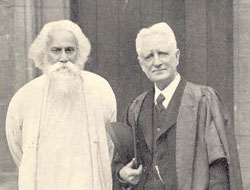
L P Jacks and
Rabindranath Tagore at Manchester College.
***
He wrote
in his book, Two Letters about the
spiritual men of India:
“The
spiritual men of India, a great and watchful multitude whose spiritual status is
unattainable, are many of them catholics in a deeper sense than we of the West
have yet given to the word….”
(source: Two
letters: L.P. Jacks in reply to C.E. Raven and F.W. Dwelly,
concerning the action of Lord Hugh Cecil against Liverpool
Cathedral -
By L P Jacks London, Oxford university press,
H. Milford, 1934. p. 26).
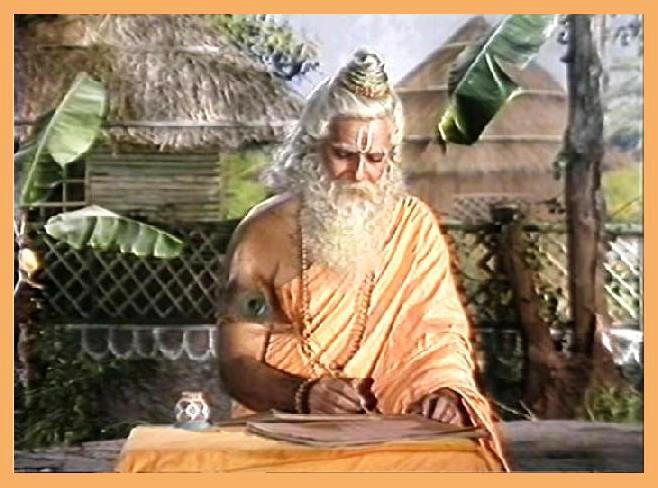
Rishi (sage) Valmiki
writing the Epic of Ramayana.
“The
spiritual men of India, a great and watchful multitude whose spiritual status is
unattainable, are many of them catholics in a deeper sense than we of the West
have yet given to the word….”
"
The sages of India discovered astonishingly subtle and profound
psycho-biophysical connections between human organism and cosmic
subterranean processes. They knew much that even today is beyond
the ken European scientific thought, or that it ignores, often
trying to conceal its helplessness by asserting that oriental
wisdom is mere mysticism, and thus showing its inability to
distinguish the rational but not yet fully understandable
essence from various figments of imagination… "
For
more refer to chapter on Greater
India: Suvarnabhumi and
Sacred
Angkor
***
 367.
Aleksandr
Georgievich Spirkin
(1918 - 2004) a
well-known Soviet psychologist, who was a corresponding member of the
erstwhile USSR Academy of Science and the head of the section of
methodological problems of Cybernetics in Scientific Council of
Cybernetics of the USSR Academy of Sciences, presents some
illuminating views in his book Dialectical
Materialism
(Progress Publishers Moscow-1983, published during the Soviet
days) about Indian's ancient explorers. 367.
Aleksandr
Georgievich Spirkin
(1918 - 2004) a
well-known Soviet psychologist, who was a corresponding member of the
erstwhile USSR Academy of Science and the head of the section of
methodological problems of Cybernetics in Scientific Council of
Cybernetics of the USSR Academy of Sciences, presents some
illuminating views in his book Dialectical
Materialism
(Progress Publishers Moscow-1983, published during the Soviet
days) about Indian's ancient explorers.
Professor
Spirkin writes:
"
The sages of India discovered astonishingly subtle and profound
psycho-biophysical connections between human organism and cosmic
subterranean processes. They knew much that even today is beyond
the ken European scientific thought, or that it ignores, often
trying to conceal its helplessness by asserting that oriental
wisdom is mere mysticism, and thus showing its inability to
distinguish the rational but not yet fully understandable
essence from various figments of imagination…
It is sometimes difficult
for us to penetrate the profound language of symbolic forms in
which this wisdom is couched, to get at the essence of that
wisdom. A full understanding of these complex problems can be
achieved only in the broad context of history and culture.
Historical experience offers us some instructive lessons for the
present day. If we look around thoughtfully at the path humanity
has passed, it is not difficult to see that the minds of the
makers of culture have been guided by the desire to achieve an
understanding and a rational transformation of the human being
himself, his bodily and spiritual organization, the preservation
and strengthening of his health. Socio-political, philosophical,
religious, moral, aesthetic and all cultural efforts in general
have tended towards this goal.
"The culture of the ancient Orient
affirmed not only ideas of man's dependence on the supernatural
forces that were external to him; there was also a tendency to
cultivate certain rules of behaviour in relation to these
forces, including techniques of training the body in relation to
these forces to regulate and perfect bodily and spiritual
processes. Various systems of exercises linked with religious
beliefs were evolved to change the state of the mind, the
consciousness, to achieve complete unity with the universe, to
become one with the energy of nature. These
techniques for influencing one's own organism through the
mechanisms of psycho-physiological self-regulation and control -
techniques that are much in fashion today – could not have
survived for centuries and have penetrated other cultures with a
different ethnos, if they had not contained some real knowledge
of the most subtle and hidden structural. Energo-informational
neuro-psychical and humoral potentials, which
even now sometimes seem fantastic to the analytical European
mind, particularly when it is fettered by stereotypes.
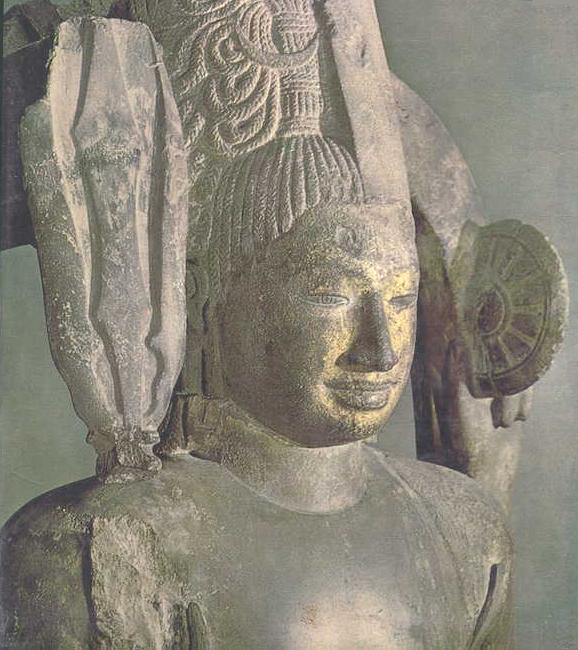
Shiva: Harihara.-
from Angkorwat.
"It is sometimes difficult
for us to penetrate the profound language of symbolic forms in
which this wisdom is couched, to get at the essence of that
wisdom."
(image source: The
Art of Southeast Asia - By Philip
Rawson).
For
more refer to chapter on Greater
India: Suvarnabhumi and
Sacred
Angkor
***
"Oriental culture is full of beliefs about the role of the
way of life and its various components – breathing techniques,
the ability to commune very subtly with nature, acupuncture,
cauterizing, and other ways of influencing the biologically
active centers of the organism, herbo-medicine, diagnostics by
means of the iris of the eye, pulse and olfactory diagnostics,
consideration of the position of the earth in relation to the
celestial bodies in medicine, the time of year and day and of
the properties of water in relation to the state of the earth
strata and the character of its flow in connection with the geo
magnetic phenomena – all this and much else has contributed to
the great wisdom of the Eastern peoples, the wealth of their
culture and man's place therein, their understanding of the
mechanisms of regulation of his life activity and vital
potentials. Thus already in the distant past, in the mists of
mythological world views the precious crystals of knowledge,
tested by the experience of centuries, of skills in beneficially
influencing man's body gradually accumulated. How could people
of those far off times know so much without any experiments or
apparatus about the conditions and factors that regulate the
course of the vital processes and the character of the
interaction between man and nature, particularly the influence
of the celestial bodies, the sun and the moon and various
radiations proceeding from outer space and the bowels of the
earth!? And all this was taken into consideration both in
diagnosing and in treatment! Does this not go to show an
astonishingly high level of culture that should arouse our
admiration, gratitude and desire to study! This knowledge could
not have retained its vitality if it had not again and again
been confirmed by practice."
(source: Dialectical
Materialism - By Aleksandr Georgievich Spirkin
p. 339 - 340).
 368.
Serge
Trifkovic ( ? ) has received his
PhD from the University of Southampton in England and pursued postdoctoral
research at the Hoover Institution at Stanford. His past journalistic outlets
have included the BBC World Service, the Voice of America, CNN
International, MSNBC, U.S. News & World Report, The Washington Times, the
Philadelphia Inquirer, The Times of London, and the Cleveland Plain Dealer. He is foreign affairs editor of Chronicles. He is the author of The
Sword of the Prophet: History, Theology, Impact on the World has
observed in his article: 368.
Serge
Trifkovic ( ? ) has received his
PhD from the University of Southampton in England and pursued postdoctoral
research at the Hoover Institution at Stanford. His past journalistic outlets
have included the BBC World Service, the Voice of America, CNN
International, MSNBC, U.S. News & World Report, The Washington Times, the
Philadelphia Inquirer, The Times of London, and the Cleveland Plain Dealer. He is foreign affairs editor of Chronicles. He is the author of The
Sword of the Prophet: History, Theology, Impact on the World has
observed in his article:
"India
prior to the Moslem invasions was one of the world’s great civilizations.
Tenth
century Hindustan matched its contemporaries in the East and the West in the
realms of philosophy, mathematics, and natural science. Indian mathematicians
discovered the number zero (not to mention other things, like algebra, that were
later transmitted to a Moslem world which mistaken has received credit for
them).
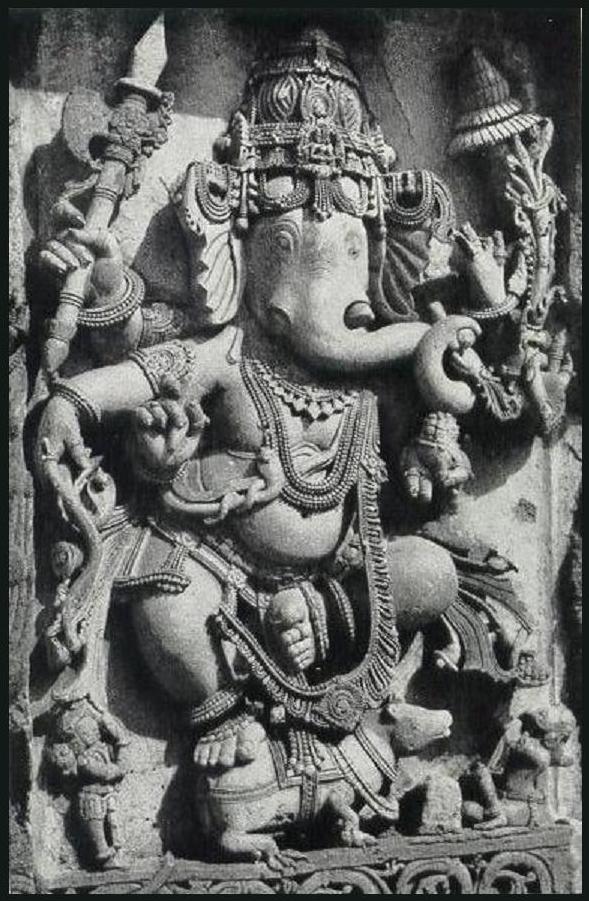
Dancing
Ganesha from Halebid, Karnataka.
(image source: The Art Heritage of India - By Ernest B. Havell
p. 148-149).
Medieval
India before the Moslem invasion, was a richly imaginative culture. Its sculptures were vigorous and sensual, its
architecture ornate and spellbinding.
For
more refer to chapter on Greater
India: Suvarnabhumi and
Sacred
Angkor
Watch Ganapati
Om Kirtan - By Dave Stringer.
***
"Medieval India, before the Moslem invasion,
was a richly imaginative culture, one of the half-dozen most advanced
civilizations of all time. Its sculptures were vigorous and sensual, its
architecture ornate and spellbinding. And these were indigenous
achievements and not, as in the case of many of the more celebrated high-points
of Moslem culture, relics of pre-Moslem civilizations that Moslems had overrun.
"
(source:
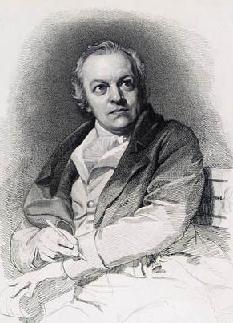 369.
William Blake
(1757—1827)
English poet, painter, and engraver,
who created a unique form of illustrated verse; his poetry,
inspired by mystical vision, is among the most original, lyric,
and prophetic in the language. 369.
William Blake
(1757—1827)
English poet, painter, and engraver,
who created a unique form of illustrated verse; his poetry,
inspired by mystical vision, is among the most original, lyric,
and prophetic in the language.
According to
author David Weir - William Blake’s poetry was due to the British discovery of
Hindu literature. His mystic system springs from the rich
historical context that produced the Oriental Renaissance.
Blake’s
poetic career underwent a profound development as a result of
his exposure to Hindu mythology.
By combining mythographic
insight with republican politics and Protestant dissent, Blake
devised a poetic system that opposed the powers of Church and
King
The reference to Brahma
in The Song of Los
shows
that Blake was able to incorporate the latest mythographic
material into his own evolving system.
Adam stood in the garden of Eden:
And Noah on the mountains of Ararat;
They saw Urizen give his Laws to the Nations
By the hands of the children of Los.
Adam shuddered! Noah faded! Black grew the sunny African
When Rintrah gave Abstract Philosophy to Brahma
in the East.
For many years now a fairly large contingent of critics has
insisted on a relationship between Blake’s work and Hindu
mythology. In 1924, S Foster Damon claimed that Blake was “in
accord with Eastern mysticism".
Urthona
is Dharma; Urizen, Karma, while both Tharmas and Luvah are
included in Maya.”
In 1947 Northrop Frye
observed in Fearful
Symmetry that:
“Blake was among the first of European idealists
to link his own traditions of thought” with the Indian
classic, taking the account of the lost drawing of “Mr.
Charles Wilkins translating the Geeta” (E 148) in Blake’s Descriptive
Catalogue of 1809 as evidence of such a link. Frye
also noted that Blake’s conception of three classes of human
beings – Angels, Devils, and Elect – “may have come from
the ‘Gunas” of the Bhagavad Gita.
Wilkins translation of the Gita are called “three Goon or
qualities arising from Prakreetee or nature, namely, “Sattwa
truth, Rajas, passion, and tamas darkness.”
Blake refers to the "Geeta" in his Descriptive
Catalogue of 1809, the same year that Moses Haughton engraved
the plates for Edward Moor’s The
Hindu Pantheon (1810), a copious account of Hindu
deities with the Sanskrit names of the gods affixed in
Devanagari script by Charles Wilkins.
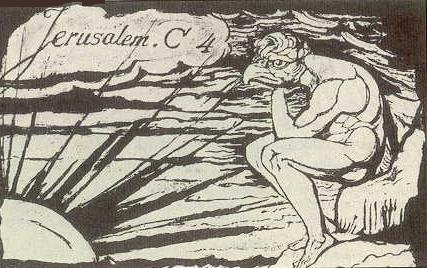
Engraving
of a spectre, plate 78, by William Blake. The most obvious
similarity is the combination of bird and human which is usual
in Indian iconography. Blake is said to have done a drawing of
two-elephant headed figures that might have been modeled after
Ganesha.
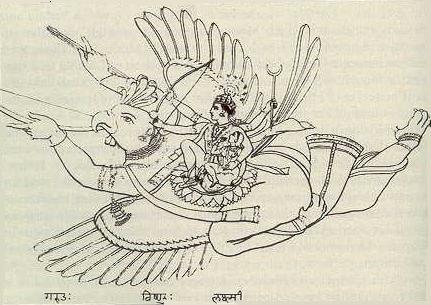
(image source: Drawings
of Garuda from Edward Moor's
The Hindu
Pantheon).
***
(source: Brahma in the West
– By David Weir p. 8 - 97).
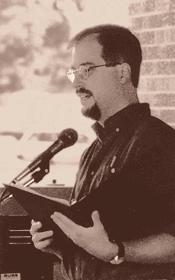 370.
Rev. Roger Bertschausen ( ? ) at the Fox Valley Unitarian
Universalist Fellowship of Appleton,
Wisconsin. 370.
Rev. Roger Bertschausen ( ? ) at the Fox Valley Unitarian
Universalist Fellowship of Appleton,
Wisconsin.
He
has written about the Philosophy of Time.
"We in the West have long had trouble
with time. Early Judaism, Christianity and Islam had no inkling of the long age
of the universe. Cosmologies from these religions were based on the
notion that the universe started at a finite point in the recent past. St.
Augustine set the beginning of the universe at 5000 BCE. For centuries, this
figure was embraced by most Westerners. (And some continue to believe it.)
Additionally, the early Christians also believed that the end of time as we know
it was close at hand.
This view of time contrasts sharply with other religious perspectives on the age
of the universe. In the Hindu tradition, for example,
one day in the life of Brahma lasts 4,300,000,000 years. And Brahma lives for
the equivalent of 311,040,000,000,000 human years. The historian of religions Huston
Smith reports one way of conceiving of the Hindu
time-frame.
We understand now from modern
physics that the Hindu concept of time is much closer to the mark than St.
Augustine's. Scientists now estimate that the universe is ten to
twenty billion years old. We do not yet know for sure if our universe will keep
expanding into infinity or if the force of gravity will at some point cause it
to cease expanding and to collapse in what is called "the Big Crunch."
Even if it turns out that the universe will eventually collapse, the Big Crunch
probably wouldn't begin for at least another ten billion years.
I find the
understandings of modern science--as well as of Hinduism--to
be very helpful in this regard. We are part of a universe that has existed for
billions of years and will likely continue to exist for billions more. The long
view that this understanding should give us has not yet fully emerged--it's hard
to unlearn centuries of believing that the universe is only several thousand
years old.
(source:
On
Time and Place: A Philosophy of Time -
By Rev. Roger Bertschausen).
For more on Cosmology refer to chapter on Glimpses_XIII
and Advanced
Concepts and Hindu
Cosmology.
Refer
to Shiva's
Cosmic Dance at CERN
- the European Center for Research in Particle Physics in Geneva.

Shiva Nataraja: Lord of Dance.
We understand now from modern
physics that the Hindu concept of time is much closer to the mark than St.
Augustine's.
***
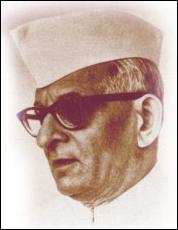 371.
Dr. K M Munshi
(1887 - 1971) A
freedom fighter, Committee
of the Indian National Congress. He founded Bharatiya
Vidya Bhavan in 1938 with the blessings of Mahatma
Gandhi. He ceaselessly strove for cultural and spiritual
regeneration. 371.
Dr. K M Munshi
(1887 - 1971) A
freedom fighter, Committee
of the Indian National Congress. He founded Bharatiya
Vidya Bhavan in 1938 with the blessings of Mahatma
Gandhi. He ceaselessly strove for cultural and spiritual
regeneration.
Dr. Munshi looked upon the Bhavan as an 'Adventure in Faith'- a
faith in India's past, present and future. It is also a faith in
India's people who have a rich and unbroken cultural heritage.
He is the author of Foundations of
Indian Culture. He has written in The Essays and
Reflections:
"The
Mahabharata is not a mere epic. It is a romance, telling the
tale of heroic men and women and of some who were divine;
it is a whole literature in itself, containing a code of life, a
philosophy of social and ethical relations, and speculative
thought on human problems that is hard to rival; but above all,
it has for its core the Gita, which is, as the world is
beginning to find out, the noblest of scriptures and the
grandest of stages in which the climax is reached in the
wondrous Apocalyspe in the Eleventh canto."
(source: The
Treasury of Hinduism - By H L Singh p. 130).
 372.
Michael Cremo (1948 - ) born in Schenectady, NY, in 1948, he received his first copy
of the Bhagavad-Gita from some Hare Krishnas
at a Grateful
Dead concert. You later joined the group and began writing for
the Bhaktivedanta Book Trust at ISKCON (International Society for Krishna
Consciousness). 372.
Michael Cremo (1948 - ) born in Schenectady, NY, in 1948, he received his first copy
of the Bhagavad-Gita from some Hare Krishnas
at a Grateful
Dead concert. You later joined the group and began writing for
the Bhaktivedanta Book Trust at ISKCON (International Society for Krishna
Consciousness).
In their 1993,
900-page tome, Forbidden
Archeology and its condensed version, Hidden
History of the Human Race, co-authors Michael Cremo and Richard
Thompson brought forth largely unknown evidence illustrating that
modern humans worked and walked the earth millions of years ago, even as far
back as 2 billion years ago.
The
idea of ape-men is not something that was invented by Darwinists of the
nineteenth century. Long before that, the ancient Sanskrit writings were
speaking of creatures with apelike bodies, humanlike intelligence, and a low
level of material culture. For example, the Ramayana speaks of the
Vanaras, a species of apelike men that existed millions of years ago. But
alongside these ape-men existed humans of our type. The relationship was one of
coexistence rather than evolution.
"The
Hindu, or Vedic, concept of time is cyclical. There are cycles within cycles
within cycles. The basic unit of this cyclical time is called the day of Brahma.
It lasts about 4.3 billion years. It's followed by a night of Brahma, which also
lasts about 4.3 billion years. The days follow the nights endlessly in
succession. During the days, life is manifested in the universe, and during the
nights it's dormant. The current day of Brahma, the one we are in now, began
about 2 billion years ago. So by this account, we should expect to see signs of
life, including human life, going back about 2 billion years on earth.
Modern geologists give the earth an age of about 6 billion years. I think there
is also a Vedic parallel here as well. First, we have to keep in mind that the
Vedic conception of the universe is that it's pretty much like a virtual reality
system, giving the conscious self a temporary domain of experience, apart from
the eternal domain of the realm of pure consciousness, or spirit. Under this
conception, I picture the earth, our particular domain of experience, as being
somewhat like a rewritable CD or DVD disk. It's erased at the end of each day of
Brahma."
'This
is an interesting parallel between the Vedic and modern scientific accounts.
Also, the day of Brahma is divided into 14 subcycles called manvantara periods,
each lasting about 300 million years. Between each one there is a devastation,
after which the earth has to be repopulated. We are now in the seventh
manvantara cycle, and that means there have been six devastations over the past
2 billion years. Modern paleontology also tells us that the history of life on
earth has been interrupted by six major extinction events, spaced at intervals
of hundreds of millions of years, the last being the one that wiped out the
dinosaurs about 65 million years ago. "
'..
true ancient Hindu cosmology was
"dismantled" by Europeans in order to bring it into
line with the biblical time scale.. this
happened during the 18th and 19th centuries. They tried to fit
everything within five thousand years."
(source:
Human
Devolution - biped.info). For more refer to Human
Devolution: A Vedic Alternative to Darwin’s Theory).
Charles
H. Townes
(1915 - )
A member of the technical staff of Bell Telephone
Laboratories from 1933 to 1947. Dr. Townes worked extensively during World War
II in designing radar bombing systems and has a number of patents in related
technology. He
invented the microwave-emitting -
MASER.
He has
observed:
“Indian
students should value their religious culture and of course, the
classical Indian culture bears importantly on the meaning of
life and values. I would not separate the two. To separate
science and Indian culture would be harmful. …I don't think it
is practical to keep scientific and spiritual culture
separate.”(source:
Interviews
with Nobel Laureates and Eminent Scholars to T. D.Singh and
Pawan K. Saharan on 19-Oct-1985, (1986) p.67).
374. Major-General
Charles Stuart - 'Hindoo' Stuart (1758- 1828) was
an
Irish man and a member of the Asiatic
Society, who
came out to India in his teens.
He seems to have been almost
immediately attracted to Hinduism and within a year of his
arrival in Calcutta had adopted the practice-which he continued
to his death-of walking every morning from his house to
bathe in and worship the Ganga according to Hindu custom.
"Incredible
as it may sound," wrote one horrified officer, "there
is at this moment a British general in the Company's service,
who observes all the customs of the Hindoos, makes offerings at
their temples, carries about their idols with him, and is
accompanied by fakirs who dress his food. He is not treated as a
madman, but would not perhaps be misplaced if he had his idols,
fakirs, bedas, and shasters, in some corner of Bedlam, removed
from its more rational and unfortunate inmates."
Stuart's
military contemporaries never quite knew what to make of their
general. One of his junior colonels, William Linnaeus Gardner,
himself a British convert to Shia Islam, wrote how "he
regularly performs his pooja and avoids the sight of beef".
Later,
Gardner
noted that Stuart was planning to take a week off to bathe at
the Kumbh Mela, where he was later seen sitting "surrounded
by a dozen naked faqueers who, joining their hands over his
head, gave him Benediction . . . Every
Hindoo he salutes with Jey Sittaramjee [Victory to Lord Ram and
Queen Sita]".
Eccentric as he may have been, Stuart was a
central figure in the history of the western appreciation of
Indian art. The
inventory of goods that Stuart left behind him when he died
indicates the degree to which he wore Indian clothes and had
taken on Indian customs such as chewing paan; it also
details the huge number of statues of Hindu deities which Stuart
appears to have worshiped. Certainly he built a Hindu temple at
Saugor, and when he visited Europe in 1804 he took a collection
of his Hindu household gods with him.
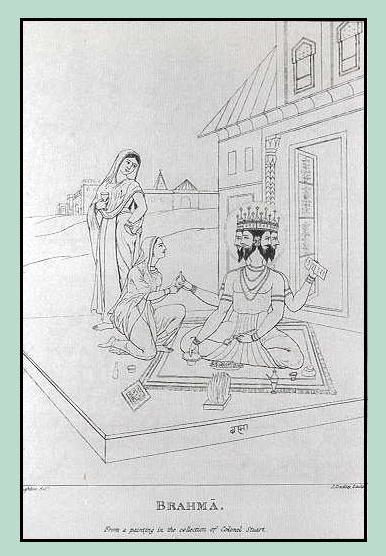
Brahma - From a
painting in the collection of Colonel Charles 'Hindoo' Stuart.
(image
source: The Hindu
Pantheon - By Edward
Moor).
***
He
learnt Indian languages and in his writings championed all
things Indian and Hindu. He opposed Christian missionary
activity and the notion that the West was morally superior. He denounced James Mill's bigoted
ideas of Hinduism and published
a pamphlet entitled Vindications of the
Hindoos by a Bengal Officer, which suggested that
'Hinduism little needs the meliorating hand of Christianity to
render its votaries a sufficiently correct and moral people for
all the useful purposes of a civilized society, and remarked
that:
"
Whenever I look around me, in the vast region of Hindoo
Mythology, I discover piety in the garb of allegory: and I see
Morality, at every turn, blended with every tale; and, as far as
I can rely on my own judgment, it appears the most complete and
ample system of Moral Allegory that the world has ever
produced."
When he died, Hindoo Stuart's
collection of Hindu sculpture-the largest and most important
ever amassed by a European-ended up in the British Museum where
it still forms the core of the Oriental collection. Stuart
himself was buried in the Christian cemetery in South Park
Street-but with his idols in his coffin and under a tomb which
takes the form of a Hindu temple, with a carved stone gateway,
the recesses on each side of which were occupied by figures
of the Goddess Ganga, Prithvi Devi.
(source: India
Britannica - By Geoffrey Moorhouse p. 89 and When
Albion’s sons went native - By W Dalrymple and Gods
and monsters – By William Dalrymple Guardian Saturday August 25, 2007).
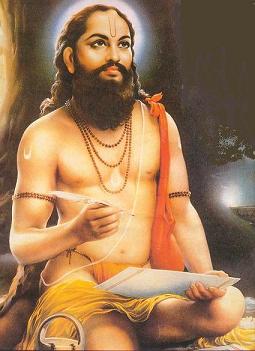 375.
Swami Samarth Ramdas
(1608
- 1682) He was a pre-eminent bhakti saint and poet. 375.
Swami Samarth Ramdas
(1608
- 1682) He was a pre-eminent bhakti saint and poet.
According
to author Historian Benoy Kumar Sarkar:
"Ramdas
was one of the greatest saints of the world. He was the inspirer
of Shivaji. Like the
Sanskrit Gita and the Tamil Kurul, the Dasabodh
is one of the greatest classics of world literature. Ramdas was
a contemporary of Sant Tukaram. As makers of Maharastra and
remakers of Hindustan, Ramdas and Shivaji
will always go
together as one ideological complex in the historical
scholarship of future generations."
He
was the last of the five great Marathi saints, wrote in a
style that is generally prose in content and expression. Devoted
to the Vishnu incarnation in Lord Rama,
he lived as a wandering mendicant visiting the temples of the
region.
One of his frequent sayings was
"Run to my help, Dear Ram. To what extremity are you
willing to see me suffer?"
Among the one composed by Ramdas
is the following:
O dear Ram, in Thy mercy meet me.
Through separation from Thee my whole being is in distress.
I cannot free myself from worldly things amongst men.
In my despondency I know not how to pass my time.
May the Almighty One not have in mind to reject me.
May there ever be kindly thought of His bhaktas.
Union with Thee I have been unable to have. How am I to acquire
it?
In my despondency I know not how to pass my time.
Victory, Victory to Ram Almighty!
The literary works of Ramdas
such as Dasabodh, Manache Shlok (verse addressed to the mind),
Karunashtakas (hymns to God) and Ramayana (describing only the
conquest of Lanka by Sri Rama and the vanquishing of Ravana) are
very popular. It was as a tribute to Ramdas's extraordinary
patience and determination in rehabilitating the Hindu religion
in India that people named him Samartha (all-powerful) Ramdas, a
name which he richly deserved. This great Guru of Maharashtra
breathed his last in 1682 at Sajjangad, near Satara, a fortress
which was given to him by Shivaji for his residence.
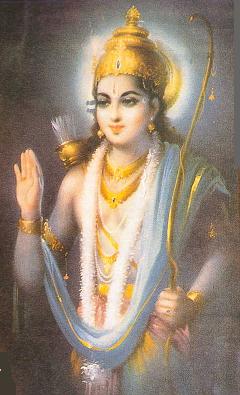
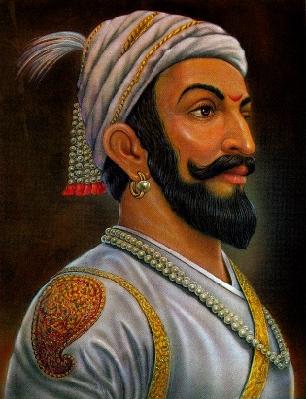
"Run to my help, Dear Ram.To what extremity are you
willing to see me suffer?" Ramdas was spiritual teacher of
the greatest of Maratha political rulers, Shivaji.
***
Ramdas was spiritual teacher of
the greatest of Maratha political rulers, Shivaji.
He has said:
"The
Bhagavad Gita teaches us that one attains union with God through
knowledge, love and action. These three must develop together so
that we can unite with God through the divination of
intelligence, love and action. This is integral yoga."
(source: Religions
of India - By Thomas Berry p. 53 - 54. Also
refer to La
Glorie du nom divin
- By J .K. Sahasrabudhe).
 376.
Devamrita
Swami ( ? )
American born, is an author and researcher specializing in the
history and knowledge of ancient India. Born in New York City,
he began his immersion in India upon graduating from Yale
University in 1972. Visiting India annually for three decades he
is an ordained sannyasi or monk, of India's Vaishnava spiritual
tradition. 376.
Devamrita
Swami ( ? )
American born, is an author and researcher specializing in the
history and knowledge of ancient India. Born in New York City,
he began his immersion in India upon graduating from Yale
University in 1972. Visiting India annually for three decades he
is an ordained sannyasi or monk, of India's Vaishnava spiritual
tradition.
"The Vedas are the largest mass of sacred knowledge from the
ancient world, and they are its most brilliant literary achievement. In the
Vedic literature we find an exquisite Weltanschanuung, a majestic world outlook
followed by millennia by a highly developed civilization.
The West, however, would benefit profoundly by seriously
exploring the value of the Vedic texts, in revealing a
completely different way of seeing the universe. And – most
important for our problems today – the Vedas reveal a
completely different way of belonging to the universe."
An uncanny confidence permeates the
Vedic texts, that the highest reality can be approached via any
subject matter. Since everything has emanated from
the supreme reality, all subjects of study are considered within
the purview of Transcendence.
The Vedas teach that conscious energy pervades the universe.
The literature asserts that from the subatomic level to the
cosmic level and even beyond, you’ll find it everywhere. The
Chandogya Upanishad says Sarvam khalv idam brahma, or
“Consciousness, indicative of the spiritual energy, is
limitless in its presence.”
The Vedas tell us that because Brahman is not subject to
material analysis, therefore its telltale evidence,
consciousness, cannot be dissected.
The Vedic presentation of Brahman
enchanted some of the 20th century’s most
influential physicists. Austrian Nobel Laureate Erwin
Schrodinger was a great fan of the
Vedas, especially the Upanishads. He found in Brahman clear
affirmation for his conceptions of “One Mind.” David
Bohm used Brahman to formulate his
idea of the “explicated order and implicate order.”
(source: Searching
for Vedic India – By Devamrita Swami p. 24 - 322).
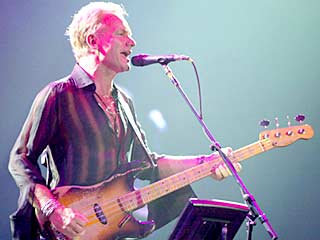 377.
Sting (1951 - )
Born in Newcastle, England in 1951, the son of a milkman, Born
Gordon Matthew Sumner in Wallsend, Northumberland. He received his name
Sting from his striped sweater in which Gordon Solomon said that
he looked like a bee. Sting,
who received the Commander of the British Empire (CBE) honour
from the queen is reportedly unimpressed with the honour and
believes it is not a big achievement to get awards from a
country that has shrunk to an island. "It's
not very big, the British
Empire. It used to be the whole world and now we
own, like, one island. It's called England" 377.
Sting (1951 - )
Born in Newcastle, England in 1951, the son of a milkman, Born
Gordon Matthew Sumner in Wallsend, Northumberland. He received his name
Sting from his striped sweater in which Gordon Solomon said that
he looked like a bee. Sting,
who received the Commander of the British Empire (CBE) honour
from the queen is reportedly unimpressed with the honour and
believes it is not a big achievement to get awards from a
country that has shrunk to an island. "It's
not very big, the British
Empire. It used to be the whole world and now we
own, like, one island. It's called England"
Rock star Sting has declared himself a Hindu in an e-mail
interview with Hindustan Times ahead of his concerts in
India in aid of Tsunami victims. Sting revealed that he feels like a
Hindu.
"In
a sense I am more of a Hindu ... I like the Hindu religion more
than anything else at the moment."
"I have become addicted to India," reveals Sting,
adding that he would like to spend the rest of his life
discovery this beautiful country. His
favorite place is Benaras (Varanasi). There is something very magical about
Benaras."
He
recalls the:
"Shiva temple that has fallen half way into the
Ganga", and says, "I find that such a wonderful,
powerful image…"
The
Goddess Theme - The female deity plays a prime role in his music. It is
something "I spend a lot of time for." Sting feels,
"We need more of the female deity in this world."
The
Concept of God - "I would not consider myself a Christian any longer. My
beliefs are much wider than that. I don't believe God is
necessarily a Catholic or Islamic or anything else...it's a much
larger concept than that..." said this latest Champion of
the Universal Religion.
Sting says, "I have a great deal of respect for
Indian music." He said that knows quite a lot about the
musical tradition of India and its intricacies. I am aware how complex ragas are, and how specific the rhythm
is." He is particularly fond of the sitar maestro Ravi
Shankar and his daughter Anoushka.
(source: Why
Sting Likes Hinduism - about.com).
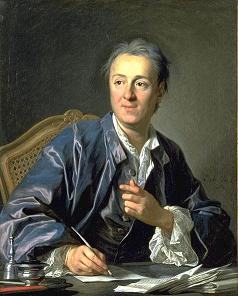 378.
Denis
Diderot (1713-84)
he was a prominent French
figure in what became known as The
Enlightenment, and was the editor-in-chief of the famous
Encyclopédie.
He was also a novelist, satirist, and dramatist. Diderot was
enormously influential in shaping the rationalistic spirit of
the 18th century. 378.
Denis
Diderot (1713-84)
he was a prominent French
figure in what became known as The
Enlightenment, and was the editor-in-chief of the famous
Encyclopédie.
He was also a novelist, satirist, and dramatist. Diderot was
enormously influential in shaping the rationalistic spirit of
the 18th century.
He
suggested in his article on
India that the “sciences may be more ancient in India than in
Egypt.”
(source:
Searching
for Vedic India – By Devamrita Swami p.
164).
379. Andrew Tomas
(1906- 2001) was an Australian
UFO pioneer, author of several books including
Mirage
of the Ages: A Critique of Christianity
and We
Are Not The First
and
On
the shores of endless worlds: The search for cosmic life
and
Beyond
the Time Barrier has written:
"A
thousand years before the
childish image of the earth drawn by Cosmas
Indicopleustes, a
scholar-explorer of the 6th century, in his Christian
Topography, philosophers had a different and much more
accurate idea of the shape of the earth.
Until the second part
of the 19th century scholars and clerics of the West
thought that the earth was but a few thousand years old. Yet
ancient Brahmin books, estimated the Day
of Brahma, the life-span of our universe, to be 4.32
billion years. This figure is close to that of our astronomers,
who calculate it to be about 4.6 billion years. "
"
The
atomic structure of matter is mentioned in the Hindu treastises Vaisesika
and Nyaya. The Yoga
Vasishta says: “There are vast worlds within the
hollows of each atom, multifarious as the specks in a
sunbeam.”
"The
Indian sage Uluku proposed a hypothesis over 2,500 years ago
that all material objects were made of paramanu, or seeds of
matter. He was then nicknamed Kanada, or the swallower of
grains."
"The
sacred writings of ancient India contain descriptions of weapons
which resembled atomic bombs. The Mausola Parva speaks of a
thunderbolt – “a gigantic messenger of deaths” – which
reduced to ashes whole armies and caused the hair and nails of
the survivors to fall out. Pottery broke without any cause and
the birds turned white. After a few hours all foodstuffs were
poisoned. The ghastly picture of Hiroshima comes to mind when
one reads this ancient text from India."
“A
blazing missile possessed of the radiance of smokeless fire was
discharged. A thick gloom suddenly encompassed the heavens.
Clouds roared into the higher air, showering blood. The world,
scorched by the heat of that weapon, seemed to be in fever,”
thus describes the Drona Parva – in
The Mahabharat.
One can almost visualize the mushroom cloud of an atomic bomb
explosion and atomic radiation.
"Another
passage compares the detonation with a flare-up of ten thousand
suns. In ancient times the day was divided into 60 kala, each
equal to 24 minutes, subdivided into 60 vikala, each equal to 24
seconds. Then followed a further sixty-fold subdivision of time
into para, tatpara, vitatpara, ima, and finally, kashta or
1/300,000,000 of a second. Is this reckoning of time a folk
memory from a highly technological civilization? Without
sensitive instruments the kashta would be absolutely
meaningless. It is significant that the kashta, or 3 x 10-8
second, is very close to the life-spans of certain mesons and
hypersons. This fact support the bold hypothesis that the
science of nuclear physics is not new."
(source: We Are Not The First:
Riddles of Ancient Science
-
By Andrew Tomas
p. 15 - 49 and 49 - 55).
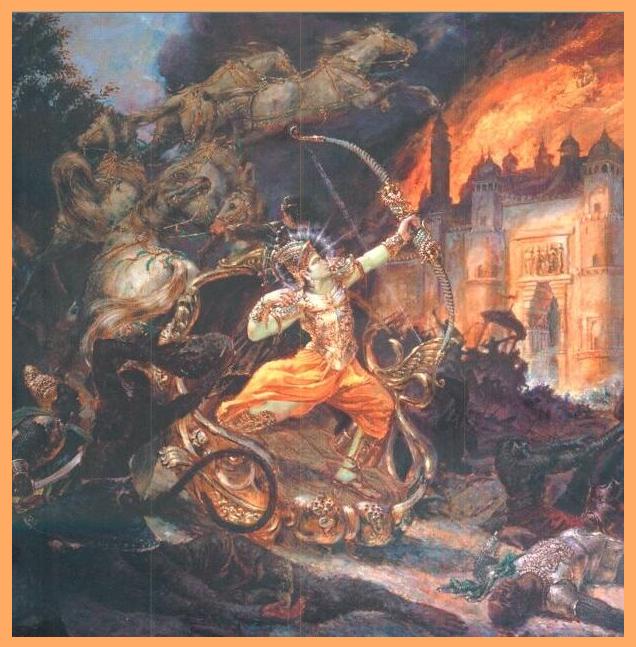
Lord Rama in
epic battle with Ravana.
Dr.
Fredrick Soddy had a great regard for the Indian epics of
Ramayana and The Mahabharata. In 1909
when academics were first beginning to grasp the awesome power
of the atom,
he
did not take these ancient records as fable.
For
more refer to chapter on Greater
India: Suvarnabhumi and
Sacred
Angkor
***
 380.
Frederick
Soddy (1877 - 1956) English born scientist. Studied in the
University of Oxford. From 1900 to 1902 and was Chemistry
assistant in the University of McGill, Montreal, where he
co-worked with Rutherford.
He received in 1921 a Nobel Prize Laureate in Chemistry. 380.
Frederick
Soddy (1877 - 1956) English born scientist. Studied in the
University of Oxford. From 1900 to 1902 and was Chemistry
assistant in the University of McGill, Montreal, where he
co-worked with Rutherford.
He received in 1921 a Nobel Prize Laureate in Chemistry.
He
awarded the Nobel
prize in 1921 - ""for his contributions
to our knowledge of the chemistry of radioactive
substances, and his investigations into the
origin and nature of isotopes"
In 1903, with Sir William
Ramsay,
Soddy verified that the decay of radium produced helium.
He
had a great regard for the Indian epics of Ramayana
and The Mahabharat. In 1909
when academics were first beginning to grasp the awesome power
of the atom, he
did not take these ancient records as fable.
In the Interpretation
of Radium (1909) he wrote these lines:
“Can we not
read into them some justification for the belief that some
former forgotten race of men attained not only to the knowledge
we have so recently won, but also to the power that is not yet
ours?”
When Dr Soddy
wrote the book, the atom-bomb box of Pandora had not yet been
opened.
In 1909 when
academics were first beginning to grasp the awesome power of the
atom, physicist Frederick Soddy wrote in his Interpretation of
Radium: "I believe that there have
been civilisations in the past that were familiar with atomic
energy, and that by misusing it they were totally
destroyed."
(source: We Are Not The First:
Riddles of Ancient Science - By Andrew Tomas p.
53). For more refer to chapter on War
in Ancient India and Vimanas.
Top
of Page
Quotes381_400
Show
in alphabetical order
 
Page < 1 2 3 4 5 6 7 8 9 10 11 12 13 14 15 16 17 18 19 20 21 22 23 24 >
|